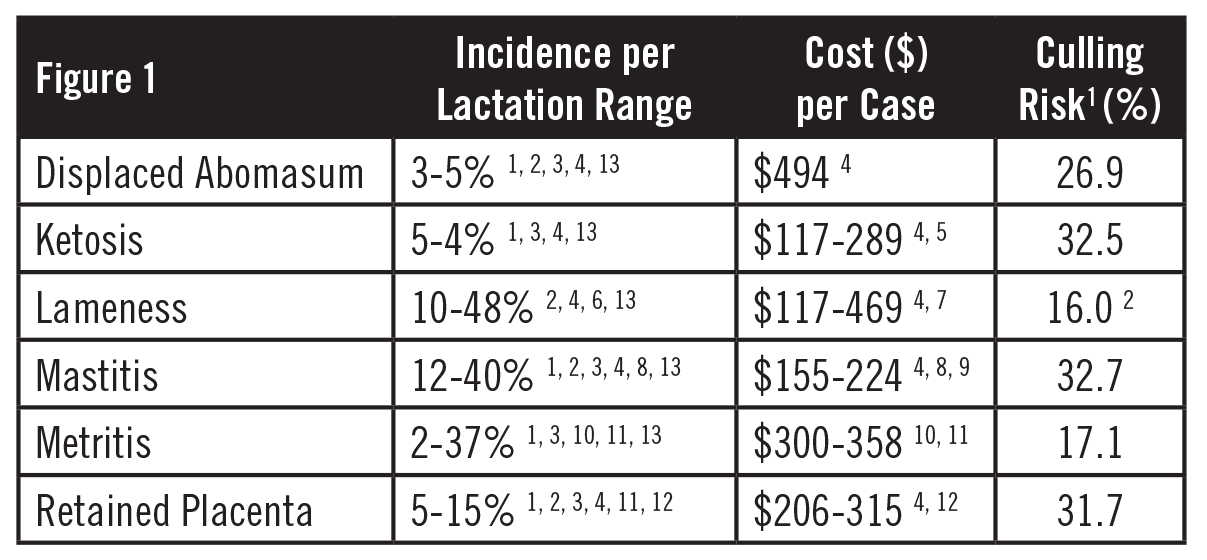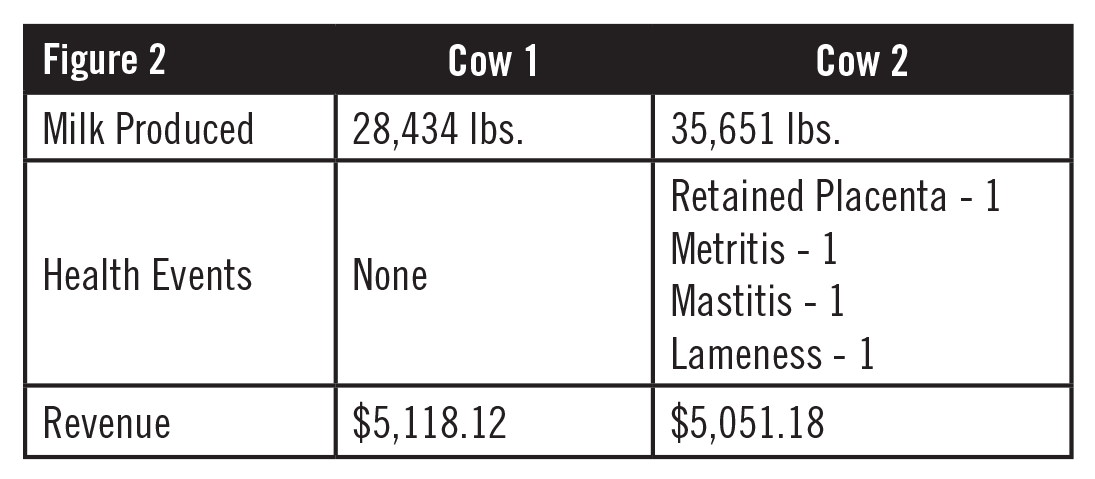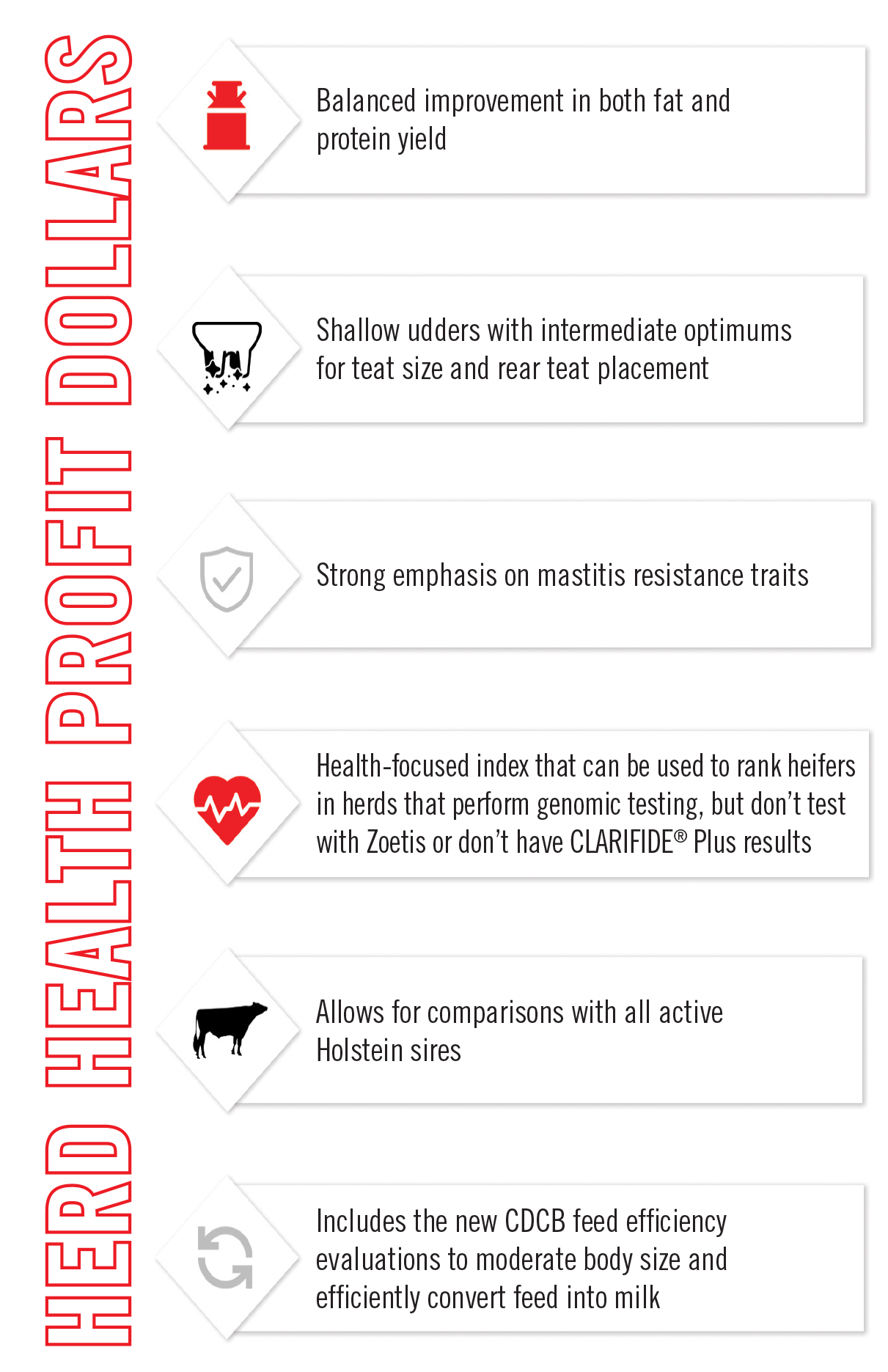Do we want high-producing cows with no concern for low butterfat and protein content? A resounding “no” comes from the dairy farms that I visit. As milk processors continue to increase the price to haul milk, farmers can’t afford to pay for hauling water. We want cows that produce high volumes of fat and protein (solids).
We understand what makes a cow reproductively efficient. No matter how you measure it, pregnancy rate, calving interval, days open, or services per conception, we want cows that breed back soon after the voluntary waiting period (VWP) and calve consistently in the same month every year.
What about longevity? It takes nearly two lactations for a cow to repay her heifer raising costs, so it’s important to create cows that have the highest return on investment potential.
We all want healthy cows but has anyone ever considered how important a healthy cow is to a dairy’s bottom line? Below is a snapshot of the cost of some common illnesses and disorders.

The economics related to these illnesses are important to determine your most profitable cow. Consider my example in Figure 2 for two cows using $18/cwt milk and the values from Figure 1.

Under these conditions, Cow 1 was a more profitable cow even though she produced 7,217 fewer pounds of milk. I don’t consider Cow 2 to be an atypical cow for our herds today and at first glance I would have said that the cow producing 7,217 more pounds of milk would be more profitable, but I had never done the math. Doing so is incredibly compelling and brought to light the economic importance of healthy cows.
Take this one step further and focus on one very costly health event: mastitis. Thirty-two percent of U.S. dairy cows experience clinical mastitis. With all the advancements made in milking equipment, prep routine and teat dips, this is still an alarming rate. With the production levels some of our cows are achieving, I’m not confident that any products or technology can thwart this rate. Improvement is going to have to come from within the cow, genetically.
What can we do as a genetics company to not only control mastitis, but in turn create more revenue generating opportunities by doing so? When focus is placed on a specific genetic trait, we can make incredible advancements in performance related to this trait. The Holstein breed has placed more emphasis on Daughter Pregnancy Rate (DPR) in recent years and because of this we are seeing breed increases in many reproductive performance indicators. Imagine if we placed more emphasis on mastitis resistance? Well, we have done that for you at Select Sires through a new index.

Herd Health Profit Dollars™ (HHP$™) places strong emphasis on health traits, particularly mastitis resistance (CDCB MAST) and Somatic Cell Score (SCS), which receive a relative emphasis of 19% in the formula compared to only 5% in TPI® and 3% in Net Merit (NM$). Another distinguishing feature of HHP$ is that some emphasis is placed on udder traits. HHP$ strives for shallower udders with an intermediate approach to teat size and rear teat placement.
HHP$ includes the latest genetic information from CDCB on feed efficiency, however, it uses a slightly different approach from other industry indexes. HHP$ includes negative weighting for stature and Residual Feed Intake (RFI) to genetically improve feed efficiency, but it does not reward animals that rank low for Strength or high for Dairy Form.
To be profitable and sustainable, dairies must leverage genetics by breeding for productive, trouble-free cows that last well beyond their third lactation. Nonetheless, it’s important to understand that avoiding mastitis and maintaining low cell counts is a significant challenge for cows in their third or greater lactation. HHP$ prioritizes selection for mastitis resistance and is designed to create profitable, longer-lasting cows.
As you consider the future and potential for sustaining the next generation, your herd’s genetic profile can be a significant factor. By emphasizing health and wellness genetics, you can secure better profit margins – regardless of the milk market.
HHP$ is not just another selection index. It is an innovative tool that can bring immense value to your dairy and help sustain the operation for years to come.
1 Gröhn YT, et al. Effect of Diseases on the Culling of Holstein Dairy Cows in New York State. Journal Dairy Sci 1998;81(4):966-978. 2 USDA.Dairy 2007, Part II: Charges in the U.S. Dairy Cattle Industry, 1991—2007 USDA-APHIS-VS. CEAH. Fort Collins, CO. 2008. #N481.0311. 3 Bar D., et al. Effect of repeated episodes of generic clinical mastitis on milk yield in dairy cows. Journal Dairy Sci 2007;90(10):4643-4653. 4 Guard C. 2009. The costs of common diseases of dairy cattle. Central Veterinary Conference Proceedings. Kansas City, MO. 5 McArt J.A., et al. 2015, Hyperketonemia in early lactation dairy cattle: a deterministic estimate of component and total cost per case. J of Dairy Sci 2015;98(3):2043-2054. 6 Bicalho RC. Lameness in Dairy Cattle: A debilitating disease or a Disease of Debilitated Cattle? Western Dairy Management Conference, 2011;73-83. 7 Cha E, et al. The cost of different types of lameness in dairy cows calculated by dynamic programming. Preventive Veterinary Medicine 2010;97(1):1-8. 8 Cha E, et al. Optimal insemination and replacement decisions to minimize the cost of pathogen-specific clinical mastitis in dairy cows. Journal Dairy Sci 2014;97(4):2101-2117. 9 Cha E, et al. The cost and management of different types of clinical mastitis in dairy cows estimated by dynamic programming. Journal Dairy Sci 2011;94(9):4476-4487. 10 Overton M, Fetrow J. Economics of postpartum uterine health, in Proceedings. Dairy Cattle Reproduction Council Convention 2008;39-44. 11 The Value of Uterine Health: the Diseases, the Causes, and the Financial Implications. Dairy Cattle Reproduction Council. 12Guard C. Retained Placenta: Causes and Treatments. Advances in Dairy Technology 1999;11:81. 13 Zwald NR, Weigel KA, Chang YM, Welper RD, Clay JS. Genetic Selection of Health Traits Using Producer-Recorded Data. I. Incidence Rates, Heritability Estimates, and Sire Breeding Values. J of Dairy Sci 2004;87:4287-4294.










